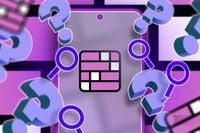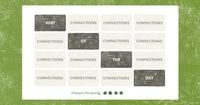Connections, a popular game from the New York Times, challenges players to find associations between seemingly unrelated words. On April 19, 2025, players tackled puzzle #678, which featured a variety of categories that tested their word association skills. The game, which first launched in June 2023, has quickly gained a following due to its unique premise: players must sort 16 words into groups of four based on shared themes, all while avoiding more than four mistakes.
For those seeking assistance with today’s Connections, we’ve compiled hints, categories, and answers to help you navigate the puzzle successfully. Each group of words is connected by a common idea, which can range from straightforward associations to more abstract concepts.
Today’s yellow category is titled SPOKEN PRESENTATION, with the words ADDRESS, LECTURE, SPEECH, and TALK. These words all relate to forms of verbal communication, making them easy to identify for those familiar with public speaking.
The green category focuses on ADJECTIVES FOR A DESERT, which includes the words DRY, HOT, SANDY, and VAST. Each of these adjectives describes characteristics commonly associated with desert environments, such as the Sahara, known for its extreme temperatures and arid conditions.
In the blue category, players encountered DOG BREEDS, INFORMALLY, featuring the words BULLY, CHOW, GOLDEN, and LAB. Here, the term BULLY is often associated with pit bulls, while GOLDEN refers to the popular Golden Retriever breed. This category might pose a challenge for those less familiar with informal dog nomenclature.
Lastly, the purple category, titled REPRESENTED BY THREE-DIGIT NUMBERS, includes CANNABIS, DEVIL, INTRO CLASS, and JAMES BOND. Each of these words can be associated with a specific three-digit number: CANNABIS is often linked to 420, DEVIL to 666, INTRO CLASS to 101, and JAMES BOND to 007. This category is particularly intriguing as it requires players to think outside the box and make connections that may not be immediately obvious.
For those struggling with the puzzle, the article offers several tips for solving Connections effectively. One strategy is to look for similar parts of speech among the words, grouping them based on whether they are nouns, verbs, or adjectives. Additionally, players should be on the lookout for synonyms, as some categories may consist of words that are closely related in meaning.
Another useful approach is to say the words out loud, as this can help clarify their connections. For example, a previous puzzle included words like GO, RATE, and SPEED, all related to motion. However, only a subset of those words would be used in a prompt to encourage someone to move quickly.
Players should also be prepared for red herrings—words that seem to fit a category but ultimately do not. For instance, in a past puzzle, words like BUD and CORONA might suggest a category related to beer, but they were intended for a different grouping altogether.
Finally, players are encouraged to shuffle the board if they find themselves stuck. Moving words around can reveal new patterns and connections that may not have been initially apparent. If all else fails, players can always return to the hints provided, as they can often offer the necessary nudge to unlock the correct associations.
As the game continues to evolve, players are reminded that there will always be another puzzle to tackle. Each day presents new challenges that may align with personal interests, giving players an edge in their attempts to solve the game. With a little practice and the right strategies, anyone can become adept at Connections.
In summary, today’s Connections puzzle featured four distinct categories that tested players’ word association skills. The yellow category focused on verbal communication, the green on desert descriptors, the blue on dog breeds, and the purple on words represented by three-digit numbers. By employing effective strategies and keeping an eye out for tricky connections, players can enhance their gameplay experience and enjoy the challenge that Connections provides.






